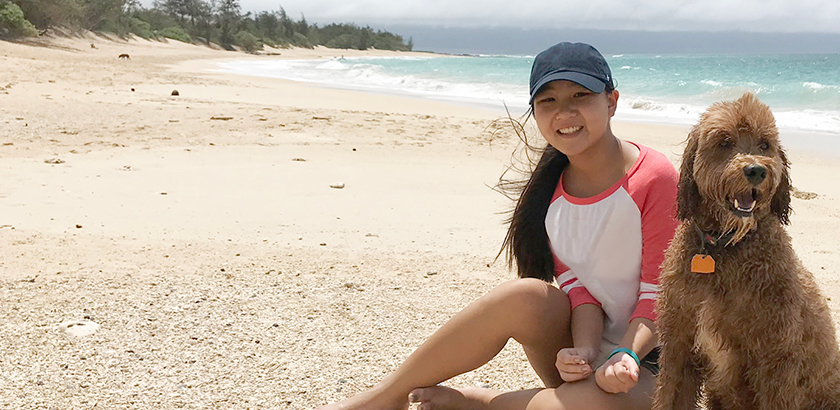At a glance
Emma is a 16-year-old living with her parents Elizabeth and Rich in Maui, Hawaii. When she developed AFM at age 14, she lost feeling and movement in both arms and both legs. Through treatment and hard work in therapy, she has made excellent progress.

Initial Symptoms
In March of 2018, Emma and her parents took a red eye flight from Maui to Alta, Utah for spring break. They were tired but had a nice day and got takeout food for dinner. After dinner, Emma stood up from the table, screamed and grabbed her neck. Her parents thought she might have a pinched nerve from the flight and put her in the bathtub to relax her muscles. Emma’s neck felt better, but she started feeling a tingling sensation in her hands, which moved up her arms, and she told her parents her legs “felt funny.”
Heading to the Hospital
Elizabeth called a local doctor friend, who came over to examine Emma. He took her temperature and blood oxygen level, which were normal. Emma started to feel nauseated and threw up. The doctor gave her Benadryl and Tylenol and recommended Elizabeth and Rich take Emma to the hospital if she threw up again. She did, and the family got in the car to go to a children’s hospital in nearby Salt Lake City. Driving through a blizzard, it took them nearly an hour to get there.
At the Hospital
By the time the family got to hospital, Emma couldn't walk or hold her arms up. Doctors ordered an MRI, but the metal in Emma's braces distorted the image, making it difficult to see clearly what was happening in her body. After the MRI, Emma wasn't breathing well, and doctors moved her into the intensive care unit (ICU). They did a lumbar puncture and started IV fluids.
The next morning, Emma's doctors said test results indicated AFM or a similar condition, acute transverse myelitis (ATM), but they weren't sure which, without additional tests. They started her on intravenous immunoglobulin (IVIG) and administered supplemental oxygen. She regained use of her legs, her breathing improved, and she was able to stop receiving supplemental oxygen. The next day, doctors administered a high dose of steroids, removed Emma's braces, and did a 4-hour MRI. The MRI showed lesions in the grey matter of her spine.
Continuing Treatment
Elizabeth and Rich decided to move Emma to a children’s hospital in Boston to see a specialist who had experience with AFM. They took a Flight for Life transfer to Boston. Doctors there continued treatment with high-dose steroids and IVIG and began plasmapheresis, physical therapy, and occupational therapy. After 2 weeks in the hospital, Emma was sent to a rehab hospital for intensive therapy. She made progress, moving her fingers first, then her wrist, and then her elbows.
Back Home
After 5 weeks in the rehab hospital, Emma was ready to head home. Back in Maui, she continued physical therapy and occupational therapy for 3-5 hours a day, 6 days a week.
Just before the family's spring break trip, Emma had been accepted into a boarding school in California, which included horseback riding, horse care, and other outdoor activities in the curriculum. Emma was committed to attending the school in the fall semester and focused on this goal. Through hard work, she regained some movement in her arms and shoulders, and by August, she was ready for school. With some adaptations, she was able to ride a horse.
Surgery
Emma continued occupational and physical therapy while in school and continued to make progress. In March of 2019, her doctor from Boston recommended nerve transfer surgery in both arms. Emma and her parents decided to proceed with the surgery in California, which is closer to their home.
Doctors operated on Emma's left arm on July 4, 2019. The 8½ hour surgery went well, though the family was rattled by an earthquake when Emma was in the recovery room. After a few weeks of recovery, doctors completed surgery on Emma's right arm. In September, she went back to school, with both arms out of slings. She resumed physical therapy 4 days each week.
Today
Emma hasn’t regained full movement in her arms and does not have sensation on the left side of her body, but she continues to make good progress. At her 6-month checkup following surgery, doctors said they could see muscle growth and changes in her shoulders.
In early 2020, she was officially diagnosed with AFM. Today, she can walk, run, swim, surf, drive, and ride a bike. She is continuing with therapy and working to help her body learn new patterns of movement. Therapy includes cranial sacral work, meditation, visualization, and working to train her brain to learn new neural pathways.
Advice to Parents Facing AFM
“Our motto is ‘Best Possible Outcome’ — we call it BPO. We don’t have a preconceived notion of what that means, but we believe Emma can come back even better, whether she gets all movement back or not. I know it’s so hard to push your kids to do the therapy, but I believe the muscles need reminding that they have a job, the brain needs to learn new pathways to accommodate new patterns of movement, and the emotional body needs to observe, allow, and accept. You have to keep the whole person supported and engaged.”
- Elizabeth, Emma's mother
